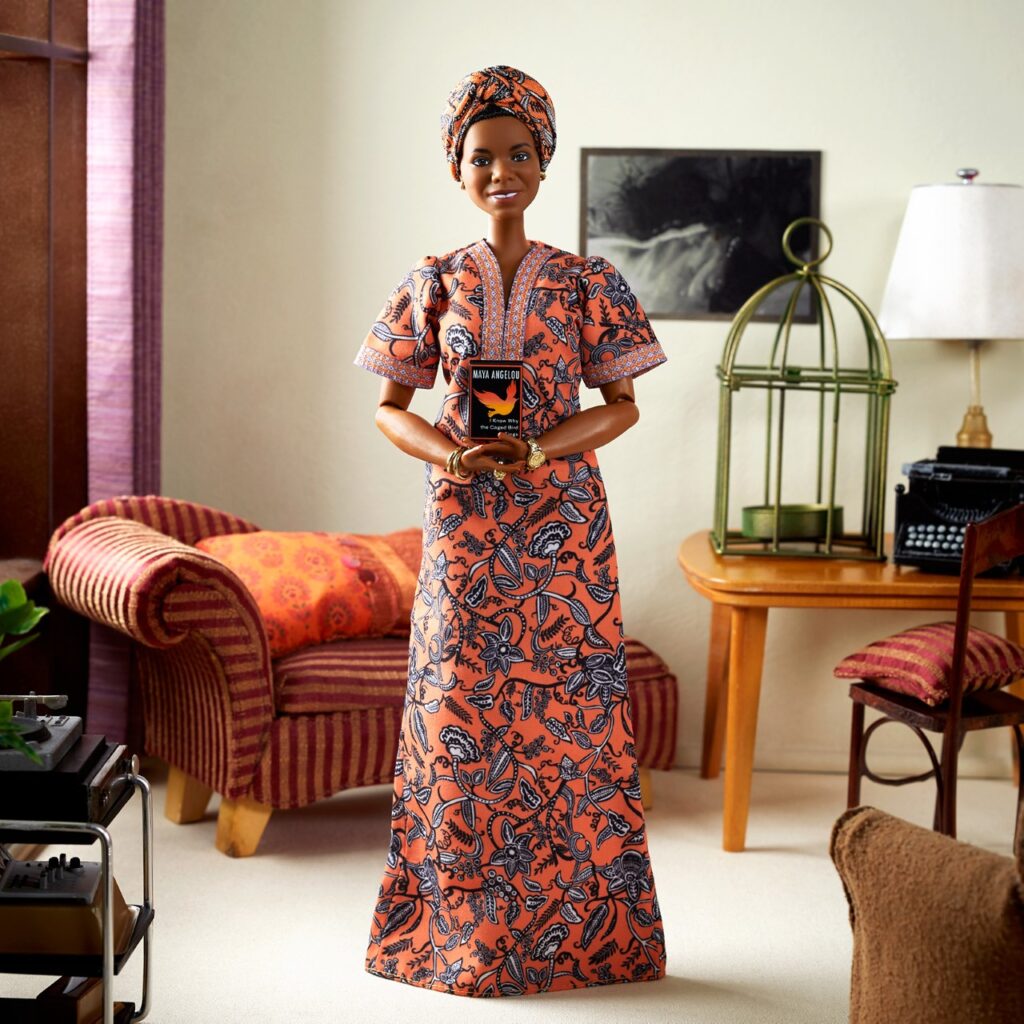
I never had a Barbie doll, no doubt because she was pricey. My mother would have shrewdly eyed all those accoutrements, separately packaged, and nipped that problem in the bud. My friends had Barbies, though, and mainly what I remember is seeing them carried upside down, blood rushing to their ponytailed scalps. We enjoyed bending their legs, and the really cool thing was Skippy or whoever she was, the little one whose hair grew. But Barbie was skinny and hard plastic, and she fast became an object to be manipulated and discarded. I could muster no tenderness for her and preferred to cradle my soft plump baby dolls.
Not having a daughter of my own, I lost touch with that hot-pink aisle of possibility until the other day, when my jaw dropped at the sight of the new Maya Angelou Barbie. Get out! Mattel got that cool? Where had I been? The doll wears a head wrap, just as Angelou did, and a long dress, both made in a fabric that looks a lot like the Ghanian patterns the writer favored. The photo has an old-fashioned typewriter on the midcentury desk behind her, next to an empty birdcage.
What it would have meant to me as a bookish child, to see such glamour in a literary life. As it was, my favorite movie (though I was far too young to understand it and have no idea why my mother let me watch it) was Valley of the Dolls, and my sole rationale was an early scene of the aspiring editor driving in New England snow. That was my first glimpse of a literary life, and I recognized my dream.
This doll, Maya, has nothing to do with barbiturates or sex or any of the other adult themes that washed right over me in the movie. Nor do her companions, who I discover are part of a series called Inspiring Women. I have rushed to the Barbie website, and tennis star Billie Jean King is here, along with astronaut Sally Ride, artist Frida Kahlo, NASA mathematician Katherine Johnson, and activist Rosa Parks. Earlier heroes are represented, too: Susan B. Anthony, Flossie Nightingale, Amelia Earhart. And Ella is here, Ella Fitzgerald, singing jazz.
Best of all, the women all look almost like themselves. Features are recognizable. Rosa wears her specs. Ella’s body type is “curvy collector.” Billie Jean King’s is “articulated superhero,” but she would have liked that. Rosa Parks has a “posable torso with articulate knee,” the better for sitting on buses.
Feeling an affectionate glow for a company I have long despised, I explore further and find the Barbie “Sheros,” among them India’s para-badminton world champion, a software engineer named Manasi Joshi. For me, there is magazine editor Ita Buttorse and journalist Martyna Wojciechowska. Their companions include a chef, a Muslim sabre-fencer, a truck driver, a boxing champion, a conservationist, and a body-positive model way curvier than the Ella doll.
I want to slap the haters who have quibbled, whining that there is not enough of a unibrow on Frida. My God, do they not see how far Mattel has come? No kid would dangle these dolls by the foot or leave them out in the rain. They have personalities, backstories, lives.
After the Barbie years, I went to an all-girls’ high school—but not a fancy one. My friends wanted to be nurses, dental hygienists, or teachers. A few set their sights on medical school. One wanted to be a vet (but became a nurse instead). One startled us by going into the convent. None of that appealed to me, and other than Valley of the Dolls, I had no menu of alternative possibilities in my head. All I knew was that I did not want to keep working in the drapery department of Dillard’s (I am so sorry, all you people whose windows I screwed up because I could not calculate triple-full pleats) or become a secretary like my mom. Even she called it “something to fall back on.”
That was a long time ago, and all sorts of paths have opened for all sorts of girls, but though I have gladly tracked the shift for years now, it took this little foray into Barbie world to drive home how different it must feel to be a girl now. In the presence of the sheros, I sit quietly, imagining all the dreams they make plausible.
It was not so long ago (okay, 1993) when a group of brilliant pranksters heard Barbie say “I hate math” and decided they were done. They bought and hacked a ton (somewhere between hundreds and thousands) of Barbies and G.I. Joes. The dolls were then returned and released back into the market—with their voice boxes switched. The hirsute warrior gushed, “I love to shop with you!” while femme Barbie hissed, “Dead men tell no lies.”
They made their point. As will these figures, who are so much more than objects to be toyed with or cuddled and cast aside. Their lives draw a force-field of dignity around them, and it is impossible to think of them the way men used to refer to sedative drugs and sexy women—as “dolls.”
Read more by Jeannette Cooperman here.
